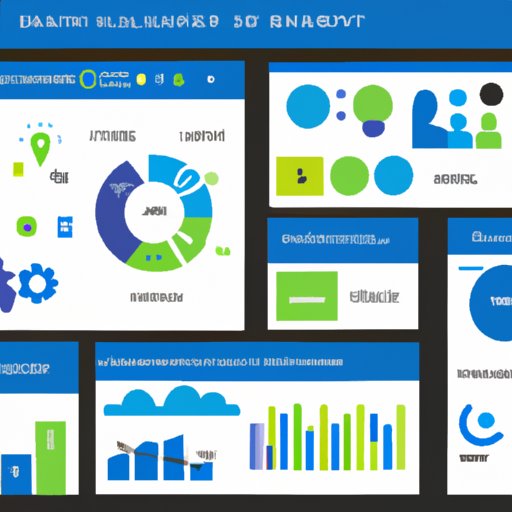Introduction
Power BI is a powerful business intelligence tool that enables users to quickly connect, visualize, and analyze data from various sources. It provides organizations with insights into their operations and helps them make informed decisions. With its intuitive interface and comprehensive features, Power BI has become one of the most popular business intelligence tools on the market.
Automation is the process of automating manual or tedious tasks to save time and resources. Automation can be applied to almost any process, including those related to Power BI. In this article, we’ll explore the numerous benefits of automating Power BI processes and provide an in-depth guide to getting started.

Exploring the Benefits of Automating Power BI
Automating Power BI processes offers a variety of benefits for organizations. Here are some of the key advantages of automation:
Increased Efficiency
One of the biggest benefits of automating Power BI processes is increased efficiency. Automation eliminates the need for manual tasks, which can take up valuable time and resources. This allows teams to focus on more strategic activities and get more done in less time. According to a study by McKinsey, “automation could raise productivity growth globally by 0.8 to 1.4 percent annually.”
Streamlined Data Analysis
Another benefit of automating Power BI processes is that it simplifies data analysis. Automation reduces the amount of time spent on mundane tasks such as data entry and report generation. This allows users to focus on more important tasks such as uncovering insights from their data. Automation also makes data analysis more efficient by reducing errors caused by manual data entry.
Improved Quality of Reports and Dashboards
Finally, automating Power BI processes can improve the quality of reports and dashboards. Automation eliminates the need for manual data entry, which reduces the chance of errors. Automation also makes it easier to keep track of changes and ensure that data is up to date. As a result, organizations can produce more accurate and reliable reports and dashboards.

A Guide to Automating Your Power BI Processes
Now that you understand the benefits of automating Power BI processes, here’s a step-by-step guide to help you get started:
Step-by-Step Guide
1. Identify the areas of your Power BI process that can be automated. Consider tasks such as data entry, report generation, and data visualization.
2. Create a plan for automating these processes. Consider the tools and software you’ll need, as well as the timeline for implementation.
3. Implement the plan. This may involve setting up automation tools, configuring workflows, and creating scripts.
4. Monitor the performance of the automated processes. Regularly review the results to ensure that they are meeting expectations.
5. Optimize the automated processes as needed. Make changes to improve efficiency and accuracy.
Tips for Automating Power BI Reports and Dashboards
Here are some tips for automating Power BI reports and dashboards:
- Use a template to simplify and standardize report design.
- Create rules for data validation to ensure accuracy.
- Set up alerts to notify you when data changes.
- Integrate Power BI with other systems such as CRM and ERP.
- Schedule regular refreshes of data to keep reports up to date.
How to Streamline Your Data Analysis with Automated Power BI
In addition to automating Power BI reports and dashboards, you can also use automation to streamline your data analysis. Here are some tips for automating your data analysis:
Automating Data Collection
The first step in automating your data analysis is to automate the collection of data. This can be done by integrating Power BI with external data sources such as ERP and CRM systems. This will ensure that data is collected in a timely and accurate manner.
Automating Data Cleaning
Once the data is collected, the next step is to automate the cleaning process. This involves using scripts and algorithms to identify and remove erroneous data. Automating this process can significantly reduce the amount of time spent on manual data cleaning.
Automating Data Visualization
Finally, you can automate the process of creating visualizations. This can be done by using templates and pre-built charts to quickly generate visuals. Automating this process can save time and ensure that the visuals accurately reflect the data.

Automation Tools for Power BI: What You Need to Know
There are a variety of tools available to help you automate your Power BI processes. Here’s a brief overview of some of the most popular tools:
Overview of Available Tools
Microsoft Power Automate is a cloud-based automation platform that can be used to automate Power BI processes. It provides a range of features such as scheduling, workflow management, and data integration. Other popular tools include ZAPier, UiPath, and Tray.io.
Comparison of Features
When choosing an automation tool for Power BI, it’s important to compare the features offered by each tool. For example, some tools offer features such as data transformation and API integration, while others offer features such as automated report generation and scheduled refreshes. It’s important to choose a tool that meets your specific needs.
Conclusion
Automating Power BI processes offers a wide range of benefits for organizations. Automation can increase efficiency, streamline data analysis, and improve the quality of reports and dashboards. Additionally, there are a variety of tools available to help you automate your Power BI processes. By following the steps outlined in this article, you can start leveraging the power of automation to streamline your data analysis and create higher quality reports and dashboards.
(Note: Is this article not meeting your expectations? Do you have knowledge or insights to share? Unlock new opportunities and expand your reach by joining our authors team. Click Registration to join us and share your expertise with our readers.)
